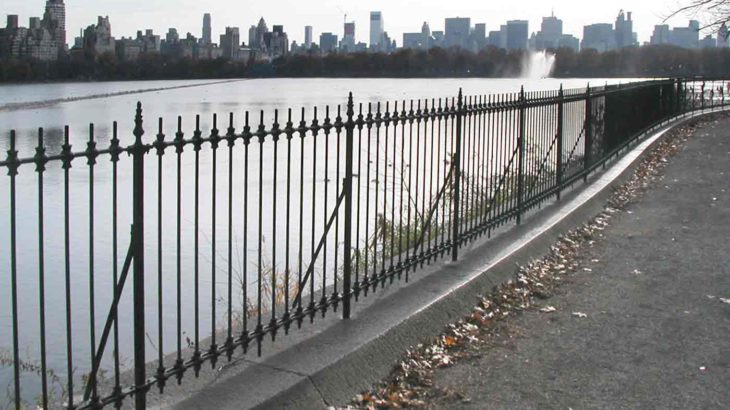The result of a Connecticut company’s “Yankee Ingenuity” is now being appreciated by the thousands of people who visit and use New York City’s Central Park every day. Welding Works of Madison, Connecticut recently completed a brand-new fence to replicate the one that surrounded the Central Park Reservoir from 1862 until 1926. The original ornamental fence was unique in design and construction, unlike any fencing normally being produced today. Welding Works was challenged to “think outside of the box” to deal with the complexities of the project. They used reverse engineering and investigated technologies used in the past to develop a workable design, fabrication and installation plan.
The American Fence Association recently recognized this Welding Works project with the organization’s Fence Project of the Year Award. Welding Works received this honor during FENCETECH’04, the Association’s annual convention and trade exhibition, held in Orlando, Florida from February 25-27, 2004. According to the American Fence Association, “The Fence Project of the Year Award is bestowed upon the company that has demonstrated unique workmanship and exemplary knowledge of fence installation.”
The original ornamental fence was unique in design and construction – its finials and ornamental unions were cast around, not fastened to, its pickets and rails. The only mechanical fasteners used were to join the panels to the posts. The replica would be installed on existing coping stone and would measure approximately 8,150 feet in length and 48 inches high (an adequate height, since the Reservoir is no longer used to supply drinking water).
Since this project had to be true to the original 1862 fence, no fasteners, pins or welds could be visible. The new panels were to be of welded construction, and this posed one of the project’s biggest challenges – developing the manufacturing methods to cast around the weldment in a cost-effective, productive manner. To ensure that the mold would fit snug at each union for dead-on castings, the first step was to create precise assembly fixtures for accuracy. The weldments needed to be ±.15 inches to guarantee that the castings would be correct. The weld fixture held the steel posts in place with pneumatic clamps and enabled two workers to weld at the same time.
Meanwhile, Welding Works also formulated a plan to ensure that the castings would match the original fence and worked hand-in-hand with mold designer Jim Case to design a unique 3-piece mold. This mold would not only ensure that sufficient iron got into the mold and filled all the gaps, but it could also be removed without damaging the casting. Since the iron would solidify almost instantly, it was a challenge to get good, tight, full castings. Case created a sandcap pouring basin that allowed extra metal to feed the mold to compensate for shrinkage during cooling.
Ultimately, over 1,400 cast iron molds were used to create 19 panel mold assemblies and 16 post mold assemblies. Before casting the unions on the panels, comprehensive load tests were performed to ensure that the fence would comply with the latest code of 200 pounds of force. It was determined that the posts could support over 900 pounds of pressure with no permanent deflection.
Welding Works has calculated that they fabricated 1,535 fence panels, each 5 feet 6 inches long, with 26 castings per panel. Each panel was joined by a post, for a total of 1,538 posts, each with 2 castings. In total, the project encompassed more than 43,000 castings.
All installation procedures were developed and tested at Welding Works before attempting installation on site. Welding Works’ Walt Camp explained, “Generally, on a field installation, you would have the opportunity to problem-solve and perfect the procedure as you go along. With such a tight schedule, we had to perfect the installation methods beforehand.”
The fence was completed and dedicated in December of 2003. It has been called the “single most dramatic change to the Park in 100 years.” It provides an unobstructed view of the Reservoir, as well as of the Manhattan skyline. There have been virtually no negative comments about the project. Christopher Nolan, the Central Park Conservancy’s Vice President for Capital Improvements, reports, “The fence has been very well-received. It restores the historic aesthetic of the Reservoir and changes people’s entire perception of Central Park.”
For more information, please contact: Welding Works, 32 New Road, Madison, CT 06443, phone: 203-245-2731, fax: 203-245-0823, email: sales@WeldingWorks.com.

